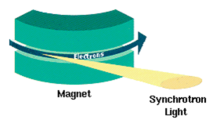
Back إشعاع سنكروتروني Arabic Radiación de sincrotrón AST Сінхратроннае выпрамяненне Byelorussian Синхротронно лъчение Bulgarian সিনক্রোট্রন বিকিরণ Bengali/Bangla Radiació de sincrotró Catalan Синхротронла пайăркалав CV Synkrotronstråling Danish Synchrotronstrahlung German Ακτινοβολία συγχρότρου Greek
Synchrotron radiation (also known as magnetobremsstrahlung radiation) is the electromagnetic radiation emitted when relativistic charged particles are subject to an acceleration perpendicular to their velocity (a ⊥ v). It is produced artificially in some types of particle accelerators or naturally by fast electrons moving through magnetic fields. The radiation produced in this way has a characteristic polarization, and the frequencies generated can range over a large portion of the electromagnetic spectrum.[1]

Synchrotron radiation is similar to bremsstrahlung radiation, which is emitted by a charged particle when the acceleration is parallel to the direction of motion. The general term for radiation emitted by particles in a magnetic field is gyromagnetic radiation, for which synchrotron radiation is the ultra-relativistic special case. Radiation emitted by charged particles moving non-relativistically in a magnetic field is called cyclotron emission.[2] For particles in the mildly relativistic range (≈85% of the speed of light), the emission is termed gyro-synchrotron radiation.[3]
In astrophysics, synchrotron emission occurs, for instance, due to ultra-relativistic motion of a charged particle around a black hole.[4] When the source follows a circular geodesic around the black hole, the synchrotron radiation occurs for orbits close to the photosphere where the motion is in the ultra-relativistic regime.



- ^ "What is synchrotron radiation?". NIST. 2010-03-02.
- ^ Monreal, Benjamin (Jan 2016). "Single-electron cyclotron radiation". Physics Today. 69 (1): 70. Bibcode:2016PhT....69a..70M. doi:10.1063/pt.3.3060.
- ^ Chen, Bin. "Radiative processes from energetic particles II: Gyromagnetic radiation" (PDF). New Jersey Institute of Technology. Retrieved 10 December 2021.
- ^ Brito, João P. B.; Bernar, Rafael P.; Crispino, Luís C. B. (11 June 2020). "Synchrotron geodesic radiation in Schwarzschild–de Sitter spacetime". Physical Review D. 101 (12): 124019. arXiv:2006.08887. Bibcode:2020PhRvD.101l4019B. doi:10.1103/PhysRevD.101.124019. ISSN 2470-0010. S2CID 219708236.
© MMXXIII Rich X Search. We shall prevail. All rights reserved. Rich X Search